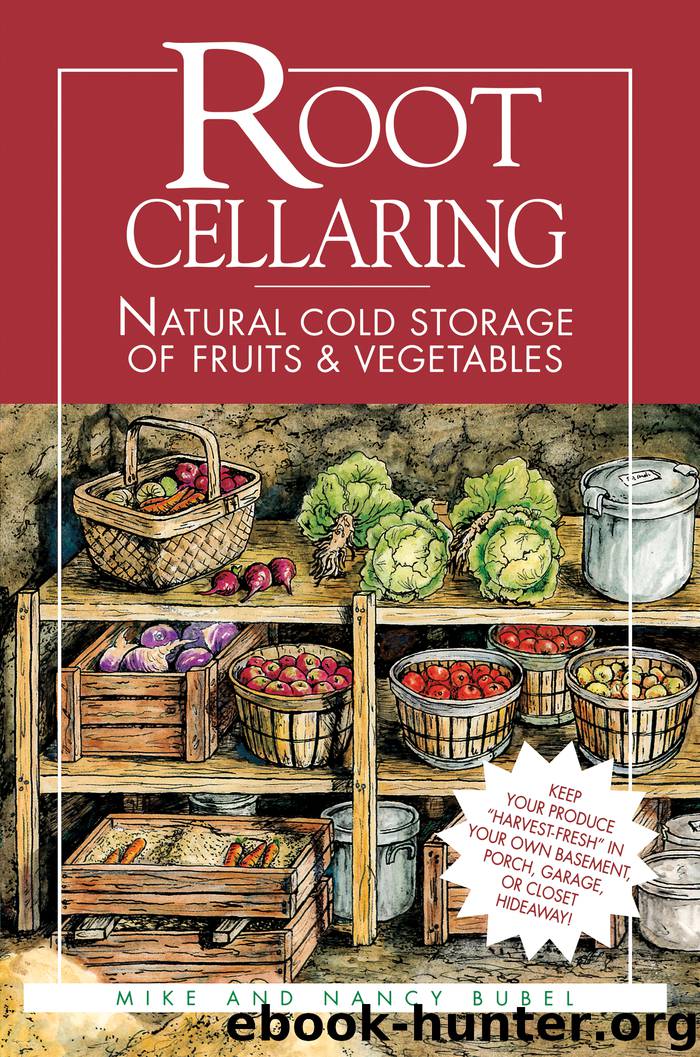Root Cellaring by Mike Bubel

Author:Mike Bubel
Language: eng
Format: epub
Tags: how to store vegetables;how to store fruits;how to build a root cellar;food storage;keeping produce fresh;overwintering produce;wintering produce;how to store potatoes;how to store onions;root vegetables;cold storage;storing the harvest;storing produce;storing vegetables
Publisher: Storey Publishing, LLC
Published: 2017-06-30T04:00:00+00:00
13
Planning Your Root Cellar
Happiness belongs to the self-sufficient.
Aristotle
The kind of root cellar you build or adapt from what you’ve already got, will depend on the floor plan of your house, the lay of your land, and the prevailing winter temperatures and snow cover in your area. If you have an old house with an unheated, dirt-floored basement room you’re all set. With slight modification, or in some cases none at all, you may have a near-ideal vegetable storage cellar. In a house with a heated basement, it may be possible to partition off an unheated corner for vegetable storage. If you prefer an outdoor root cellar, you can either dig into a hill or go straight underground and top the cellar entrance with a bulkhead door, patio, or porch. If you live in an area where winter temperatures are often below zero degrees F and snow cover is heavy, you may prefer climbing a ladder down a hatch into an under-porch storage pit to shoveling through drifts to get to a hill-cave root cellar.
If your winters are mild, with average temperatures much over 30 degrees F, you will not be able to achieve the most desirable low temperature in your cellar for the keeping of root vegetables. To compensate, though, these vegetables will probably keep very well in the garden row for you and the warm keepers like squash, onions, and sweets should do very well in a cool corner of your house.
Whether you’re modifying an existing space or building from scratch, you’ll want to consider the ground rules for a good root cellar when drawing up your plans. While it is not always possible to arrange a textbook-perfect root cellar on the homeplace with just the right moisture and temperature for each vegetable, it makes sense to understand the basic principles of root cellar construction. Then you can at least aim in the right direction. If you can’t provide ideal conditions, don’t despair. Plenty of people live quite well all winter from root cellars that don’t precisely meet all of these basic requirements. On the other hand, if you are building a storage area from the ground up, you might as well do it right.
We’re thinking, for example, of a house built for the pastor of a nearby church by his parishioners. The well-meaning builders put in a root cellar under the house, but they did not provide any means of ventilation, and the pastor, who was also an enthusiastic gardener, found that his vegetables didn’t keep as long as they should. It’s still possible to ventilate that cellar, but it would have been much easier to provide ventilation during initial construction.
You’ll find plans and drawings for different kinds of root cellars in chapters 15 and 16 of this section. Before you start nailing or digging, though, here are some important factors to consider:
There are three basic conditions your root cellar should provide. The closer you can come to approximating these ideal conditions in your vegetable storage area, the better your vegetables will keep.
Download
This site does not store any files on its server. We only index and link to content provided by other sites. Please contact the content providers to delete copyright contents if any and email us, we'll remove relevant links or contents immediately.
My Pantry by Alice Waters(2581)
The Culinary Herbal by Susan Belsinger(2454)
Food and Water in an Emergency by Food & Water In An Emergency(2373)
Asian Pickles: China by Karen Solomon(2109)
Project Smoke by Steven Raichlen(2016)
Food Storage for Self-Sufficiency and Survival by Angela Paskett(2010)
Smoke & Spice by Cheryl Alters Jamison(1898)
The Jam and Marmalade Bible by Jan Hedh(1654)
Pure Charcuterie: The Craft & Poetry of Curing Meat at Home by Meredith Leigh(1628)
Asimov's Science Fiction 020111 by Dell Magazines(1535)
Fermented Vegetables by Kirsten K. Shockey(1531)
Economic Food Storage Strategies for Disaster Survival: Start Today and Have Enough Food Your Family Will Eat to Survive Any Disaster Without Going Broke by Sandy Gee(1521)
Asian Pickles by Karen Solomon(1476)
The Ideal Pantry: Your Comprehensive Guide to Food Remedies and Preservation Techniques by Ben Night(1425)
Canning for a New Generation by Liana Krissoff(1425)
The Healthy Meal Prep Cookbook: Easy and Wholesome Meals to Cook, Prep, Grab, and Go by Amidor RD CDN Toby(1408)
Not Just Jam: The Fat Pig Farm book of preserves, pickles and sauces by Evans Matthew(1385)
The Complete Guide to Drying Foods at Home: Everything You Need to Know About Preparing, Storing, and Consuming Dried Foods by Paajanen Terri(1328)
Jams, Preserves and Chutneys by Marguerite Patten(1323)
